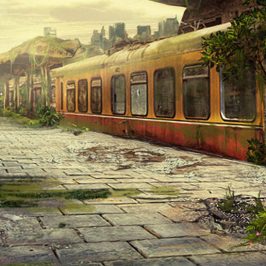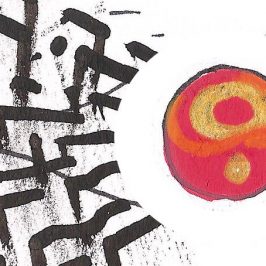Once we start recognising recurring features in the world and begin seeing patterns that converge, we tend to merge disparate part of our reckoning to build larger concepts that explain. This is undoubtedly deeply rooted in our psychology and probably an inherent part of cognition itself. Douglas Hofstadter talks of analogy as the core of cognition and his concept of ‘chunking’ mental concepts by way of analogy explores this thought in detail (if you watch that talk, skip to 13:30 when Hofstadter comes on). It is in part this line of thinking that was the original idea behind this website. The pattern which connects is an expression of the emergence that occurs when this sort of connections are made (this is of course also related to Bateson’s idea of mind).
In late 2010 I had a series of coincidental meetings, discussions and thoughts that connected different patterns in my life and so I decided to try and share this experience by exploring this process publicly. It was nothing more than a hunch and I had no idea where it would lead. Some of what happened is archived on this site but most of it probably remains obscure and visible only to me. In a way, setting up this site accelerated the convergence of patterns in my life – I’ve had more and more of these ‘coincidental’ occurrences happening. It is probably also driven by a personal need to make sense of the way my life had unfolded and bring together different aspects that seemed rather fragmented.
Connecting the pieces has been fun and to some degree therapeutic. We all need to feel whole, and connecting the different spheres of our lives is very necessary. At a very basic level, the fragmented character of our societies is the root of our collective problems. However, there is also a danger in connecting for the sake of connection, particularly if we are in a rush and don’t take the time to sit with our differences. The quality and depth of connections should not be considered secondary. The misunderstandings that arise from assuming convergence when there is really only compromise have the potential to lead to greater rifts. So, while connecting is an essential activity in order to lead a whole life we should not forget the reality of disconnection. Here, patience and acceptance of difference are necessary to achieve the deeper understanding that is needed for agreement and convergence.
I go into this at length because I’ve noticed recently that some connections I’ve taken for granted covered up deep differences that needed my attention. In the mode of connecting it is easy to accelerate convergence and ‘chunk’ concepts together in the belief that they fit neatly unto the existing structure – whether they are friendships and family relations or thought structures. Sometimes there are differences in ways of thinking and emotional processing that need to be explored thoroughly before collective understanding (and ultimately connection) can occur. Simple as it sounds, we need to take the time to sit with brokenness before we can mend what needs to be mended.
This means that we also need to pay attention to the quality of the conversational space we create together. I’ve often felt a sneaking impatience when I’ve talked to someone and they just didn’t quite get my point. But the deeper point is not connection by convincing, it must always be connection by insight. Describing, circling, turning on its head, pointing, and then some more describing. No one moves on from a particular logic by force. Moving forward (or upward or sideways) requires a willingness to let go. Also of the urge to connect by chunking. Connecting in a deeper sense, beyond just creating larger mental concepts, must to some degree be wordless, allowing us to be in the world without imposing our wants on it. In a series of meetings, for which I am extremely grateful, I have made connections which have made it clear to me that the real task for me as a historical being is to connect my different patterns into the shape of a settler.
Perhaps drawing patterns which connect is best described as a sort of settling in life with all its fragments and broken pieces.







hyubab
Great blog; it raises a lot of interesting questions. I wholeheartedly agree with your point that discerning patterns is deeply rooted in our psychology. However, to what extent do you think the desire to do so is a coping mechanism? To what extent is this drawing of patterns and making of connections an artificial attempt to impose order on something which is inherently chaotic? The events which tend to have the greatest impact on our lives are isolated and far beyond our control: the loss of a loved one, etc.
I do not disagree that on some small scale, connections are valid. However, these tend to be small islands of reason in a tumultuously chaotic ocean. Ultimately, chaos is the score upon which reality is written (Henry Miller’s words; not my own)!
jeppe
Thank you for your comment. I did not feel quite happy with this post as I had a sense that it did not quite express what I meant to say, so it is very nice to have you comment on it.
You touch on some really interesting issues and something that I was thinking a lot about a while back. Actually, this goes quite deep into what patterns that connect are about. Here, I am indebted to Gregory Bateson and his thinking about stochastic process of which both evolution and learning are examples (this is the central topic of his book ‘Mind and Nature’).
To Bateson, chaos is necessary for such processes to take place. Take evolution. To make things simple (and if I remember right) chaos and randomness are sources of difference which is essential for any progression to occur at all. In evolutionary processes selection ‘acts on’ randomness to generate variations. This is the meta-pattern that we recognise as evolution. The same goes for learning.
I guess this is why we both have a feeling that this is a natural tendency of our minds – it may be embedded into the fabric of our psychology. The interesting question you raise is how or when that then becomes a coping strategy for dealing with chaos. Perhaps we push the tendency to integrate too far when we cannot cope with the seemingly chaotic stream of events around us. This is a suspicion I have had of myself lately and the reason why I wrote that post in the first place.
Would it be fair to say that your question could also be cast in this way: ‘perhaps we want to simplify when we face a larger degree of complexity than we can handle’? I think chaos and order are part of the same thing and in an effort to avoid falling into the trap of a dualistic either/or balancing act, it may be worth re-wording the question in terms of complexity rather than chaos. Because although the world feels ‘chaotic’ it is actually highly ordered at the same time – far from white noise. It is inherently chaotic but it is also inherently ordered (thinking of fractals).
But the overwhelming complexity of this highly ordered chaos is what gets me sometimes. The point that I want to make is that it is important to avoid falling into the trap of turning away from looking at overwhelming complexity simply because it feels ‘uncomfortable’ and then create some mental category for that seeming mess (‘chaos’?) and shove it away into the dump of the unconscious. This is where it is necessary to pay attention to whether one is making a ‘connection’ or just reducing the world by simplification.
Does this make sense? This reply has already grown arms and legs, but I want to push this point a little further because this goes back to why I felt I didn’t quite hit on the point that I intended to with this post (thanks for helping me along!). If we don’t question the connections we make, or at least approach them with an inquisitive attitude, we may actually just be simplifying what is irreducibly complex. This, especially if it happens in personal relationships, can lead to a lot of distress when complexity and chaos comes jumping out of the box from what seems like nowhere.
Bateson’s project was ultimately integrative, I think, and the creation of meta-patterns which he was driving at helped give birth to some serious thinking on systems, complexity and chaos. I guess the tentative conclusion that I’m coming to is that if this move is going to work, it has to be based on an acceptance that there is never going to be one grand, unifying theory, rather it is in itself a process and as such it is better understood as a way of thinking than a theory.
Thanks for your comment, it helped complete the circle. Perhaps we can break it open now and make a different shape!